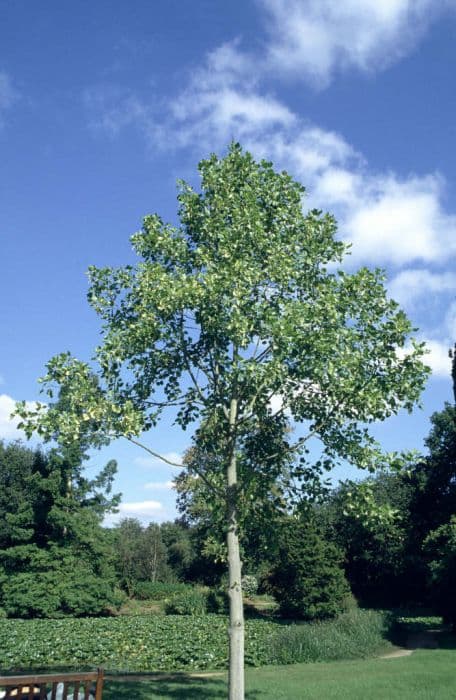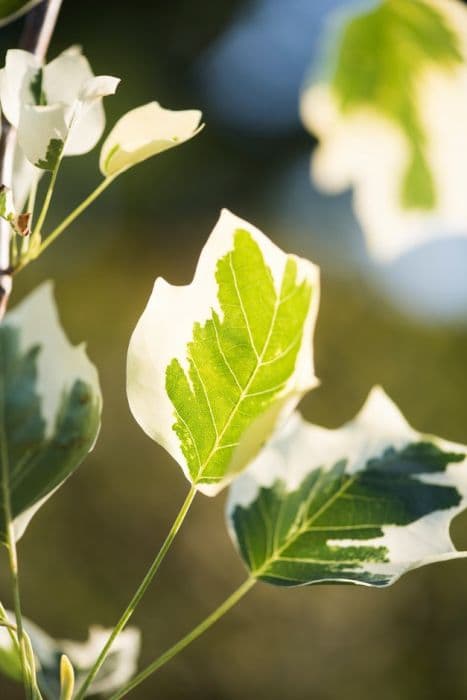Southern Magnolia Magnolia grandiflora 'Victoria'

ABOUT
The Magnolia grandiflora 'Victoria', commonly known as Southern magnolia, is a visually striking plant known for its large, showy flowers and glossy green leaves. The flowers are creamy white and have a distinctive, cup-like shape, often described as being saucer-sized. These blooms emit a strong, sweet fragrance that's particularly noticeable on warm days. Each individual flower is composed of broad petals that are thick and waxy to the touch, radiating from the center in a way that is both elegant and dramatic. As they mature, the flowers reveal a cone-like center cluster of spirally arranged carpels and stamens, which adds an intricate texture to the bloom's appearance. The leaves of the Southern magnolia are equally impressive. They are leathery, dark green, and shiny on the top with a frosted, velvety underside that has a lighter, sometimes brownish tint. These leaves are quite large and oval-shaped with pointed tips and wavy edges, creating a striking contrast against the creamy whiteness of the magnolia flowers. After blooming, the Southern magnolia develops fruit that starts as a green pod and gradually turns to a dark brown as it matures. These fruit pods open to reveal bright red seeds, which hang on slender threads, adding a burst of color and interest to the tree even after the flowers have faded. The overall appearance of the Southern magnolia 'Victoria' is one of grandeur and Southern charm, making it a popular plant for gardens where it serves as a focal point of beauty and fragrance.
About this plant
 Names
NamesFamily
Magnoliaceae
Synonyms
Southern Magnolia, Bull Bay
Common names
Magnolia grandiflora 'Victoria'.
 Toxicity
ToxicityTo humans
Southern magnolia is generally considered non-toxic to humans. Ingesting parts of the plant is unlikely to cause serious poisoning. However, in rare cases or when consumed in large quantities, it may result in gastrointestinal discomfort or other mild symptoms.
To pets
Southern magnolia is typically safe for pets, with no significant toxicity reported. Ingesting its leaves or blossoms might cause mild gastrointestinal upset in some animals but is unlikely to cause serious harm.
 Characteristics
CharacteristicsLife cycle
Perennials
Foliage type
Evergreen
Color of leaves
Green
Flower color
Creamy-white
Height
60-80 feet (18-24 meters)
Spread
30-50 feet (9-15 meters)
Plant type
Tree
Hardiness zones
7-9
Native area
Southeastern United States
Benefits
 General Benefits
General Benefits- Aesthetic Appeal: Adds a striking ornamental feature to landscapes with its glossy, evergreen foliage and large, fragrant white flowers.
- Shade Provider: Grows into a large tree that offers ample shade in gardens and parks.
- Habitat for Wildlife: Attracts pollinators like bees and serves as a habitat for birds who nest in its branches.
- Privacy Screen: Can be used effectively as a natural screen for privacy due to its dense foliage.
- Seasonal Interest: Offers year-round interest with its evergreen leaves and seasonal blooms typically in late spring and summer.
- Drought Tolerance: Once established, it is relatively tolerant to drought, requiring less frequent watering compared with other plants.
- Low Maintenance: Requires minimal pruning and care once established, making it ideal for those looking for low-maintenance landscaping options.
 Medical Properties
Medical Properties- Anti-inflammatory: Magnolia grandiflora contains compounds that may reduce inflammation.
- Anxiolytic: Extracts from the plant could potentially have an anxiety-reducing effect.
- Antioxidant: It has components that are known for their ability to combat oxidative stress.
- Antimicrobial: The plant may possess antimicrobial properties that could help in fighting certain infections.
- Neuroprotective: Some chemicals within Magnolia grandiflora may offer protection to nerve cells, which could be beneficial in neurodegenerative diseases.
 Air-purifying Qualities
Air-purifying QualitiesThis plant is not specifically known for air purifying qualities.
 Other Uses
Other Uses- Magnolia leaves can be used to create a natural dye for fabrics, imparting a rich green or brown color depending on the mordant used.
- The plant's strong wood is sometimes utilized in furniture making or woodworking projects, offering a material with good workability and finish.
- Leaves of the Magnolia grandiflora can serve as sturdy and attractive bookmarks due to their size and durability.
- The large petals of the Magnolia flower can be used in artistic arrangements or as a natural bowl for displaying small items.
- Dried Magnolia seed pods become unique elements in crafting, potentially used as part of homemade wreaths or as decoration in flower arrangements.
- Due to its broad leaves, the Magnolia grandiflora can be utilized in thematic garden designs, such as creating a 'living wall' for privacy or decor.
- Magnolia leaves can be incorporated into table settings for special events, serving as natural place mats or decorative accents.
- The wood chips of Magnolia grandiflora are sometimes employed in smoking meats, adding a subtle, sweet-smoky flavor to the food.
- In educational settings, the Magnolia grandiflora can be used to study plant biology and botany, demonstrating the characteristics of flowering plants.
- The Magnolia's seed cones may be used in ornamental applications, like creating unique jewelry pieces or as components in mixed media art.
Interesting Facts
 Feng Shui
Feng ShuiThe Southern magnolia is not used in Feng Shui practice.
 Zodiac Sign Compitability
Zodiac Sign CompitabilityThe Southern magnolia is not used in astrology practice.
 Plant Symbolism
Plant Symbolism- Persistence: The Southern magnolia is known for its robustness and ability to thrive in diverse conditions, symbolizing endurance and perseverance.
- Dignity: With its grand appearance and stature, the Southern magnolia represents nobility and a dignified character.
- Beauty: The Southern magnolia's large, creamy-white flowers and glossy leaves make it a symbol of striking beauty and elegance.
- Femininity: The delicate, fragrant blossoms of the Southern magnolia are often associated with the softness and grace of femininity.
- Hospitality: As a staple in southern landscapes, the Southern magnolia is a symbol of warm, welcoming hospitality traditional to Southern culture.
- Longevity: The Southern magnolia trees can live for centuries, symbolizing long life and connection with the past.
 Water
WaterSouthern Magnolias, including the 'Victoria' variety, need regular watering to establish deep root systems, especially during the first few years. Once established, they can tolerate some drought. The plant should be watered deeply once a week with about 1.5 gallons of water for smaller trees (less than 10 feet tall), increasing the amount as the tree matures. During hot and dry periods, water twice weekly. During winter, reduce watering to every two to three weeks, depending on the soil moisture level.
 Light
LightSouthern Magnolias thrive in full sun to partial shade. They should be planted in a spot where they can receive at least 4 to 6 hours of direct sunlight daily. Dappled light is also suitable, but avoid deep shade as it can lead to fewer flowers and a thin canopy.
 Temperature
TemperatureSouthern Magnolias are hardy in a range of temperatures and can survive minimum temperatures down to around 20 degrees Fahrenheit. They prefer a climate with hot summers and cool winters, with ideal temperatures ranging from 70 to 90 degrees Fahrenheit. They may suffer from frost damage if temperatures fall below 20 degrees Fahrenheit.
 Pruning
PruningPrune Southern Magnolias to maintain their shape and remove dead or diseased branches. The best time for pruning is after flowering in late spring or early summer. Light pruning can be done annually, but major pruning should be done sparingly, as Magnolias do not require heavy pruning and can be damaged by over-pruning.
 Cleaning
CleaningAs needed
 Soil
SoilSouthern magnolia prefers well-draining, acidic to neutral soil with a pH of 5.0 to 6.5. A mix containing organic matter like compost or peat moss, along with perlite or sand for improved drainage, works well for this plant.
 Repotting
RepottingSouthern magnolias are slow-growing trees and do not require frequent repotting. Young trees can be repotted every 2-3 years, but mature trees are often planted directly in the ground.
 Humidity & Misting
Humidity & MistingSouthern magnolias do well in moderate humidity but are adaptable to both lower and higher levels. No specific humidity requirements are needed beyond the average outdoor environment.
 Suitable locations
Suitable locationsIndoor
Place in bright, indirect light and ensure large enough pot.
Outdoor
Plant in full sun to partial shade and shelter from strong winds.
Hardiness zone
6-10 USDA
 Life cycle
Life cycleThe Southern Magnolia (Magnolia grandiflora 'Victoria') begins its life cycle when a seed germinates, typically in moist, rich soil. During the seedling stage, the plant develops its primary root and begins to sprout its first leaves, relying on the nutrient reserves from the seed. As it enters the vegetative stage, the plant continues to grow and develop a woody stem, branches, and larger, glossy evergreen leaves, with energy produced through photosynthesis. The Southern Magnolia reaches maturity within 10 to 15 years, entering the reproductive stage where it produces large, fragrant white flowers during late spring and summer, followed by the development of conelike fruit that releases red-coated seeds. After pollination, the seeds are dispersed by wildlife, thus enabling the cycle to continue. This plant has a long life span and can live for over a century under optimal conditions.
 Propogation
PropogationPropogation time
Spring-Early Summer
Propogation: The Southern Magnolia (Magnolia grandiflora 'Victoria') is often propagated through semi-hardwood cuttings, which is considered the most popular method for this plant. Propagation is best done in the late summer when the current season's growth has started to mature but is not yet fully hardened, ensuring the cuttings have enough vigor to root successfully. To propagate by cuttings, a 4-6 inch (10-15 cm) long stem piece with several leaves is taken. The lower leaves are removed, and the cut end is often treated with a rooting hormone to enhance root development. The cutting is then placed in a well-draining rooting medium, ensuring the growth conditions are adequately moist and warm, with high humidity and indirect light being essential for rooting success. It generally takes several weeks for the cuttings to root, after which they can be transplanted into individual pots to grow on before being planted out.









